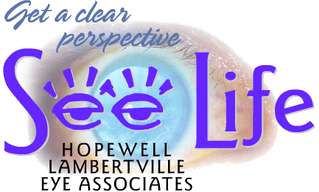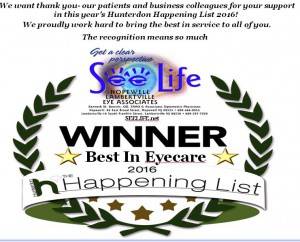Hopewell Lambertville Eye Offers Far More than Wellness Eye Care – we offer comprehensive medical – health care complemented by the use of the most advanced technology in the eye – care field.
In fact, in many cases, Dr. Daniels was an investigator and assisted in the development and certification of many of the technologies through his work as the former Director of Cornea and Contact Lens Research at the Pennsylvania College of Optometry and as a consultant to several of the medical devices companies.
The use of advanced technologies allows our doctors to optimize the care for our patients and their visual function and outcomes. As well, it allows us to properly co-management our patients with our ophthalmic surgeons and medical colleagues to assure the long-term health of our patients.
Vmax (PSF) – Digital refraction / Encepsion Spectacle Lenses / Wavefront Contact Lenses
The PSF (Point Spread Function) Refractor, coupled with Encepsion lenses, creates a fully integrated system that provides measurably better vision to address variant needs of vision – The PSF Refractor offers the first true Night Vision evaluation of vision. As well, the PSF is coupled with additional Wavefront technology to assist in the design and fitting of Encepsion Digital Lenses and Wavefront Digital based contact lenses yielding “HD” level of vision.
“HD” High Definition Vision Via the reduction of visual aberrations





Meibomianography is non invasive transilluminating light probe and an infrared camera system to evaluate a small central region of the lid margin.1 Meibomiangraphy exposes the meibomian glands, which, under healthy circumstances, have a piano-key-like appearance. Abnormal glands, on the other hand, will appear tortuous, dilated, congested or atrophied. This is advanced imaging differentiates from of eye lid disease that may be associated to medications or systemic conditions such as Roscea.
TearLab Osmolarity System
Tearlab Osmolarity System is a measure of the tear osmolarity of the human tears to aid in the diagnosis of dry eye in patients uspected or symptomatic of Dry Eye Syndrome (DES) performed in conjunction with other clinical methods.


MiBo Thermoflo

With over 30 million people suffering from chronic dry eye, now we have a solution to help you. The MiBo Thermoflo which will provide you an affordable and comfortable solution to improve your suffering.
MiBo ThermoFlo delivers consistent emissive heat to the meibomian glandular apparatus. Inspissated lipid secretions are softened and mobilized through gentle ocular message. Liberated surfactants and improved lipid secretions create an enhanced tearfilm. Improved corneal wetting reduces or eliminates the signs and symptoms of ocular surface disease. Evaporative dry eye is the leading cause of dry eye. Improving meibomian gland function is the mainstay of modern therapy. MiBo is a new treatment modality designed to addressed obstructed meibomian glands and foster superior lipid health and function. MiBo is comfortable, effective, convenient, and affordable.
ClearPath Diabetes Screener

The ClearPath device measures the amount of sugar within the lens of the eye. A higher value of sugar in the lens equates to a higher blood sugar level. ClearPath has been shown to detect your diabetic risk up to 7 years in advance of abnormal blood findings associated with vascular disease. The technology complements A1c measures but as well is consider a more specific – sensitive measure using AGE (advanced glycosylated end-product).
The ClearPath DS-120 measures autofluorescence via a confocal microscope scan of the crystalline lens of the eye that takes 7-8 seconds. In independent scientific studies published in peer-reviewed journals, elevated autofluorescence measurements have been linked to high levels of advanced glycosylated end products, which accumulate in the presence of diabetes and uncontrolled glucose over time. By detecting early and co-managing diabetes with a primary care provider. This allows us to potentially discover and intervene when there is a high suspicion of diabetes and more accurately the known diabetic patient.
Frequency Doubling Technology (FDT) perimetry (Visual Field)

Frequency Doubling Technology (FDT) perimetry (Visual Field) is a novel perimetric test that provides rapid screening (45 to 60 seconds) and full-threshold (4 to 5 minutes) testing for detection of retinal or neurological association vision deficit or loss. Used to screen for retinal disease, glaucoma, and neurological disorders such neoplasms or tumors.
Zeiss Humphrey 750i Visual Field Perimeter

The visual field is measured by perimetry. This is a kinetic interactive test, where spots of light are shown on the white interior of a half sphere and slowly moved inwards until the observer sees them, or static, where the light spots are flashed at varying intensities at fixed locations in the sphere until detected by the subject. Commonly used perimeters are the automated Zeiss – Humphrey Field Analyzer or FDT Visual Field Analyzer. The test is performed to evaluate the risk of retinal disease, glaucoma, associated systemic disease such as diabetes, high blood pressure, effects of high risk medications, and neurological functions.
Oculus Easy Field: Visual Field – Perimetry
OCULUS Easyfield®
The OCULUS Easyfield® is the smallest full-fledged perimeter on the market. It is designed for use as a visual field screener and as a threshold perimeter for immediate re-examination of any abnormal findings. Ideal for all common examinations of the central visual field up to 30°. The Easyfield® C has an adjustable double chin rest and uses translucent eye shields for maximum patient comfort. The Oculus incorporates the enhanced Glaucoma Staging System (GSS 2) of Brusini and the Glaucoma Staging Program (GSP).
Visual Fields: Importance of an Eye Exam: Finding Painless Eye and Systemic Disease
- Normal Binocular Visual Field
- Bitemporal Heminanopia – Pitutary Tumor
- Right Heminanopia – Occipital Tumor or Stroke
- Binasal Hemianopia Chaismal Tumor
- Glaucoma
- Macular Degeneration
Heidelberg Retinal Tomography: Retinal and Glaucoma Imaging
The Heidelberg Retina Tomograph uses scanning laser tomography to produce 3-dimensional images, which allow precise measurements of optic nerve head parameters. This technology by Heidelberg Engineering is used to differentiate between normal eyes and glaucomatous eyes even before visual field defects are present. The retinal module allows imaging and disagnosis of disease such as macular degeneration, vitre-retinal issues, trauma … As well, it allows for accurate comparison on follow-up examination.
OptoVue iFusion System: Retinal – Corneal Imaging: Optical Coherence Tomography
Optical coherence tomography (OCT) is a non -invasive imaging technology for performing high-resolution cross-sectional imaging of the ocular anatomy. OCT is analogous to ultrasound imaging.
OCT can provide cross-sectional images of eye – tissue structure(s) on the micron scale in situ and in real time to assist in the diagnosis and treatment of corneal, vitreo – retinal, glaucoma and higher level ocular – systemic disease that effects the eyes.
Corneal Pachymetry
A pachymeter is a device that uses ultrasound to determine the thickness of the cornea (the clear tissue in front of the coloured iris). Pachymetry is an essential measurement prior to certain refractive surgical procedures, such as LASIK. Procedures such as LASIK remove tissue from the cornea and, therefore, pachymetry is important to be certain that the cornea will retain a safe amount of central tissue thickness. A measure of corneal thickness is also important when measuring the pressure inside the eye. If corneal thickness measurements are thicker or thinner than average the intraocular pressure may be overestimated or underestimated. This is very important when following or testing for glaucoma.
Visual Function via iTrace Wavefront Aberrometry – Corneal Topography
The iTrace is the only device that uses ray tracing for wavefront analysis. It sequentially projects 256 parallel light rays through the entrance of the pupil and detects where each beam of light lands on the retina and how much light energy is transferred. Reviewing this retinal spot pattern point-by-point provides insight into a patient’s overall visual function while also enhancing the outcomes of contact lens, spectacles, cataract and refractive surgery.
By integrating wavefront aberrometry with corneal topography, the iTrace can objectively map the internal optics of the eye by subtracting corneal from total aberrations. In under a minute, the iTrace generates a complete profile on a patient’s topography, wavefront, autorefraction, keratometry, day to night vision, pupillometry, white to white and more.

Nidek OPD Scan III
The OPD-Scan III is an aberrometer providing optimal and facilitated eyeglass prescription with detailed measurement data. The easy-to-understand reports displayed on a tablet allow simple explanation of examination results.
The OPD-Scan lll is the Five-in-One true refractive workstation combining
- Wavefront Aberrometer
- Topographer
- Auto Refractometer
- Auto Keratometer
- Pupillometer and Pupillographer

TMS – 4 Corneal Topography System
Corneal topography, also known as photokeratoscopy or videokeratography, is a non-invasive medical imaging technique for mapping the surface curvature of the cornea, the outer structure of the eye.
Used to detection, diagnose, monitoring, and treatment of various eye conditions. And in the fitting contact lenses and for planning surgery, including cataract, laser vision correction.
Corneal Anatomy – Dry Eye and Disease detection / surgical management
Customized Contact Lens Design Keratoconus – Orthokeratology – Mutlifocal
In House Optical Lens Edging – Finishing System: Coburn

This advanced lens edging system allows our optical staff to personal customize and fabricate your eyeglasses in house, when not prohibited by a vision plan. The technology is equipped with seven step bevel types and five edging styles, creating a perfect, sturdy fit for all frames. It is easy to process high curve lenses and lenses with various coatings due to a more powerful wheel and flexible adaptive chuck. Complex processing, including variable asymmetric, is fast and easy due to height adjustability.
Advanced Technologies In Contact Lenses Irregular Cornea, Keratoconus, Dry Eye, Post Operative Refractive Surgical , Transplant, Multifocals (Presbyopia)
Gas permeable contact lenses are rigid lenses made of durable plastics that allow oxygen to pass through the lens. Many design can be developed to address and afford the highest quality of vision.
Combination of a gas permeable contact lens with an infused juncture into a soft lens material yielding high level comfort and stability while incorporating optimal optics of gas permeable materials and design.
Scleral contact lenses are a specific type of gas permeable contact lenses that are designed to vault over the cornea and rest entirely on the whites of the eyes (known as the “sclera”). They accommodate irregular corneal surfaces while resting “white” of the eye with a much higher degree of stability. The space behind the scleral contact stores fluids, maintaining the eye’s natural moisture and making these lenses a fantastic choice for dry eyes that cannot tolerate traditional contact lenses.
Advanced Technology In Myopia (Nearsightedness) Control
Myopia is an epidemic – not just being an issue of a visual correction, but an issue of risk of developing severe ocular disease and pathology such as retinal detachments, maculopathy, glaucoma as well as the everyday visual challenge of reduced vision. There is an answer – myopia control contact lenses and glasses. The culprit is the progressive axial length growth of the eye based on visual and exogenous influences. Based on multiple clinical studies, if one or more parents are nearsighted – the children will follow suite. Simple behavioral changes can assist such as time out doors, reducing time of digital technology and excessive near – point work, frequent ocular breaks every 20-minutes – 2 minute break – and look 20 feet away.
EDOF (extended depth of focus) lenses decrease the peripheral defocus to enhance the retinal imaging and decrease the axial length growth of the eye
Orthokeratology refers to the use of gas-permeable contact lenses that temporarily reshape the cornea to reduce refractive errors such as myopia, hyperopia and astigmatism.
Coming to the US: DIMS spectacle lens: (Hoya): MiyoSmart is an innovative spectacle lens for myopia. MiyoSmart with D.I.M.S. (Defocus Incorporated Multiple Segments) and SightGlass (Peripheral Diffsuion) curbs myopia progression in children in average by 60%3




